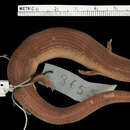en
names in breadcrumbs


Brachymeles orientalis was elevated to full species status only recently, after close investigation of genetic and morphological data revealed this Philippine endemic to be unique. It is considered one of the large-sized species in the genus, and is quite common in the southeastern Philippine islands. B. orientalis has five fingers and five toes. The genus Brachymeles represents a unique group of semi-burrowing (semi-fossorial) lizards in that the group possesses species with a full spectrum of body forms, from limbed species with five fingers and five toes, to fully limbless species. Researchers are interested in the process and patterns behind the evolution of these drastic changes in body form. With the exception of two species from Borneo (B. apus) and Thailand (B. miriamae), all species of Brachymeles are endemic to the Philippines. This means they are found among the more than 7,000 Philippine islands and nowhere else in the world.
We have evaluated this species against the IUCN criteria for classification, and find that it does not qualify for Critically Endangered, Endangered, Vulnerable, or Near Threatened status. Brachymeles orientalis has been documented to have a broad geographic distribution and is quite abundant at all sampled localities. We therefore classify this species as Least Concern, LC (IUCN, 2010).
Brachymeles orientalis can be distinguished from congeners by the following combination of characters: (1) body large (SVL 97.6–112.3 mm); (2) pentadactyl; (3) Finger-III lamellae six or seven; (4) Toe-IV lamellae eight to ten; (5) limbs relatively long; (6) supralabials six or seven; (7) infralabials six or seven; (8) pineal eye spot present; (9) supranasal contact absent; (10) prefrontals not contacting on midline; (11) enlarged chin shields in two pairs; (12) nuchal scales undifferentiated; (13) fourth and fifth supralabial below eye; (14) auricular opening present; (15) dorsolateral stripes absent; and (16) mid-dorsal stripes absent.
Dorsal ground color homogeneous medium-brown; sharp lateral demarcation between dorsal and lateral and ventral coloration; lateral and ventral surfaces of body bright burnt orange, orange-brown, or salmon colored; dark-brown spots and longitudinal lines of spots absent from lateral surfaces. Limbs medium-brown dorsally, burnt orange to orange-brown ventrally. Dorsal head scales uniform medium-brown.
Brachymeles orientalis is known from Bohol, Samar, Leyte, Dinagat, Camiguin Sur islands, and the eastern and central portions of Mindanao Island in the Philippines.
The species is quite common throughout its range with the exception of Bohol Island (CDS personal observation), and occurs sympatrically with four other species of Brachymeles in different parts of its range (Brown, 1956; Brown and Rabor, 1967; Brown and Alcala, 1980). Brachymeles orientalis occurs sympatrically with B. boholensis on Bohol Island, B. gracilis hilong and B. samarensis on Samar and Leyte islands, B. gracilis hilong on Mindanao Island, and B. cf. gracilis hilong on Camiguin Sur Island (CDS pers. observ.). Similar to B. boulengeri, B. orientalis appears to have a wider geographic distribution that spans multiple Philippine islands. This is in contrast to the pentadactyl, island endemic species, B. boholensis, B. tungaoi, and B. mindorensis, which are known from just Bohol, Masbate, and Mindoro islands respectively. As do all members of the genus, disturbed individuals move in a rapid serpentine manner and always attempt to burrow back into loose soil or humus.
Mindanao Pleistocene Aggregate Island Complex (PAIC; Brown and Diesmos, 2002).
Brachymeles orientalis occurs in agricultural areas as well as disturbed and secondary growth forest. On Samar, Leyte, Mindanao, and Camiguin Sur islands, this species occurs in primary forest, and on Bohol Island it is present in mature secondary growth. Individuals have been observed under piles of rotting coconut husks, in the humus material within rotting logs, and in loose soil and leaf litter surrounding the root networks of trees.
Brachymeles orientalis most closely resembles B. makusog and B. schadenbergi, but differs from both taxa by having six or seven Finger-III lamellae, eight to ten Toe-IV lamellae, and the fourth and fifth supralabial below the eye, and by the presence (vs. absence) of reddish-orange to salmon-colored scales on the lateral surfaces of the body. Brachymeles orientalis can further be distinguished from B. makusog by having a greater maximum axilla–groin scale row count and a greater maximum paravertebral scale row count. and from B. schadenbergi by having no contact between supranasals, and by the absence of continuous, dark mid-dorsal stripes and dark lateral stripes.
SVL 84.7–115.2 mm
The southern burrowing skink (Brachymeles orientalis) is a species of skink endemic to the Philippines.[1]
The southern burrowing skink (Brachymeles orientalis) is a species of skink endemic to the Philippines.